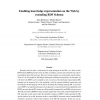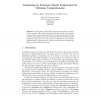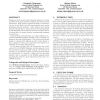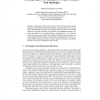129 search results - page 12 / 26 » Modeling how humans reason about others with partial informa... |
BIOINFORMATICS
2007
13 years 7 months ago
2007
The formal representation of mereological aspects of canonical anatomy (parthood relations) is relatively well understood. The formal representation of other aspects of canonical ...
DLOG
2000
13 years 9 months ago
2000
Recently, there has been a wide interest in using ontologies on the Web. As a basis for this, RDF Schema (RDFS) provides means to define vocabulary, structure and constraints for ...
DLOG
2009
13 years 5 months ago
2009
Abstract. In this paper, we describe an approach for ontology comprehension support called model exploration in which models for ontologies are generated and presented interactivel...
SIGADA
2004
Springer
14 years 1 months ago
2004
Springer
Existing security models require that information of a given security level be prevented from “leaking” into lower-security information. High-security applications must be dem...
SEMWEB
2005
Springer
14 years 1 months ago
2005
Springer
Information retrieval systems have to deal with uncertain knowledge and query results should reflect this uncertainty in some manner. However, Semantic Web ontologies are based on...




